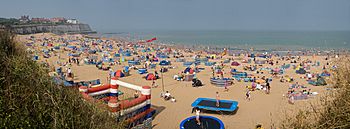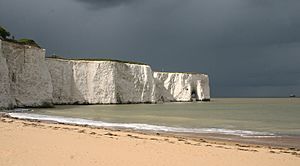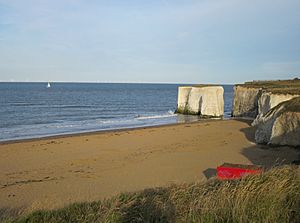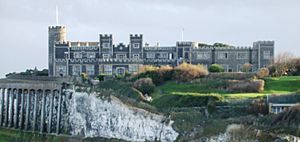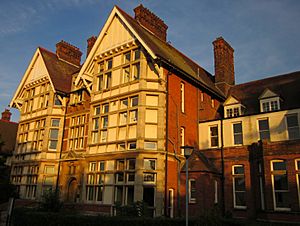Broadstairs facts for kids
Quick facts for kids Broadstairs |
|
|---|---|
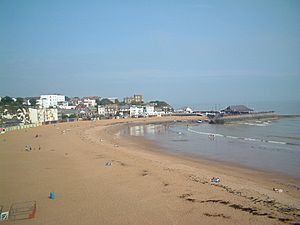 Viking Bay, Broadstairs |
|
| Population | 24,903 (Broadstairs and St Peter's parish 2011) |
| OS grid reference | TR395675 |
| • London | 81.6 miles (131.3 km) |
| Civil parish | |
| District |
|
| Shire county | |
| Region | |
| Country | England |
| Sovereign state | United Kingdom |
| Post town | Broadstairs |
| Postcode district | CT10 |
| Dialling code | 01843 |
| Police | Kent |
| Fire | Kent |
| Ambulance | South East Coast |
| EU Parliament | South East England |
| UK Parliament |
|
Broadstairs is a coastal town on the Isle of Thanet in the Thanet district of east Kent, England, about 80 miles (130 km) east of London. It is part of the civil parish of Broadstairs and St Peter's, which includes St Peter's, and had a population in 2011 of about 25,000. Situated between Margate and Ramsgate, Broadstairs is one of Thanet's seaside resorts, known as the "jewel in Thanet's crown". The town's coat of arms's Latin motto is Stella Maris ("Star of the Sea"). The name derives from a former flight of steps in the chalk cliff, which led from the sands up to the 11th-century shrine of St Mary on the cliff's summit.
The town spreads from Haine Road in the west to Kingsgate (named after the landing of King Charles II in 1683), a hamlet in St Peter parish in the north, and to Dumpton in the south (named after the yeoman Dudeman who farmed there in the 13th century). The hamlet of Reading (formerly Reden or Redyng) Street was established by Flemish refugees in the 17th century.
Contents
History
Before 1400
The inland village of St Peter's was established after the building of a parish church in about 1080. The coastal confederation of Cinque Ports during its mediæval period consisted of a confederation of 42 towns and villages in all. This included St Peter's, as a 'limb' of Dover. On the nearby coast was a cliff-top shrine, the Shrine of Our Lady, at what was then called Bradstow(e), meaning "broad place" (perhaps referring to the wide bay).
A fishing settlement developed in the vicinity of the shrine in the 14th century. This came to be called "Broadstairs", after a flight of steps which was made in the cliff to give access to the shrine from the bay. Older forms of the name include Brodsteyr Lynch (1434 & 1494 ), Brodestyr (1479), Broadstayer (1565) and Brod stayrs (1610). Charles Culmer, son of Waldemar, is supposed to have reconstructed the stairs in 1350.
1400–1700
In 1440, an archway was built by George Culmer across a track leading down to the sea, where the first wooden pier or jetty was built in 1460. A more enduring structure was to replace this in 1538, when the road leading to the seafront, known as Harbour Street, was cut into the rough chalk ground on which Broadstairs is built, by another George Culmer. Going further in defence of the town, he built the York Gate in 1540, a portal that still spans Harbour Street and which then held two heavy wooden doors that could be closed in times of threat from the sea. Richard Culmer was the son of Sir Richard Culmer by his first wife and was born in 1640/41.
Richard was buried in the parish church of Monkton, on the Isle of Thanet. Of his legacies was the endowment on Broadstairs of an area of six acres (24,000 m²) of ground for the poor of the parish. The name survives to this day as "Culmer's Allotment" as does the allotment.
1700–1815
In 1823, Broadstairs had a population of about 300. A brief outline of the history of Broadstairs Pier is given in Broadstairs, past and present, which mentions a storm in 1767, during which Culmer's work was all but destroyed. At this time, it was of considerable importance to the fishing trade with catches as far afield as Great Yarmouth, Hastings, Folkestone, Dover and Torbay and elsewhere being landed. It had become so indispensable that the corporations of Yarmouth, Dover, Hythe and Canterbury with assistance from the East India Company and Trinity House subscribed to its restoration with a payment of £2,000 in 1774.
By 1795, York Gate needed repair to repel any threat from the French Revolutionary Wars. The subsequent renovation was undertaken by Lord Hanniker in the same year as the first lightvessel was placed on the Goodwin Sands.
On the occasion of the landing at Thanet of Major Henry Percy of the 14th Dragoon Guards, on 21 June 1815 with the captured French eagle standard taken at Waterloo, a tunnel stairway from the beach to the fields on the cliff tops above was excavated, and christened "Waterloo Stairs" to commemorate the event. Broadstairs was supposedly the first town in England to learn of this historic victory, although there is no written evidence of this.
Smuggling was an important industry in the area, and the men of Broadstairs and St Peter's became very good at outwitting customs agents. This was very profitable because of the very high duty payable on tea, spirits and tobacco. There is a network of tunnels and caves strewn in the chalk strata which were used by smugglers to hide their contraband.
Development as a seaside resort
By 1824 steamboats were becoming more common, having begun to make over from the hoys and sailing packets about 1814. These made trade with London much faster. The familiar sailing hoys took anything up to 72 hours to reach Margate from London, whereas the new steamships were capable of making at least nine voyages in this time.
Mixed feelings must have been strongly expressed by the Thanet boatmen in general, as the unrivalled speed of the steam packet was outmanoeuvring all other classes of vessel, but it brought a new prosperity to Thanet. In the middle of the 19th century, the professional classes began to move in. By 1850, the population had reached about 3,000, doubling over the previous 50 years. Due to the fresh sea air, many convalescent homes for children opened towards the end of the 19th century.
Railways
Although numerous holidaymakers were attracted to Broadstairs and to other Thanet seaside towns during the Victorian era, it was not directly served by the railways until 1863. This was a time of great expansion for railways in the South East; in 1860 Victoria Station had been completed, followed by Charing Cross and Cannon Street. Rail access to Broadstairs had previously relied heavily upon coach links to other railway stations in the district or region; with firms such as Bradstowe Coachmasters, operated by William Sackett and John Derby, principally involved. Their coaches connected Broadstairs to Whitstable station where a railway service had begun as early as 1830 (one of the first in England, with its pioneering Stephenson's engine Invicta).
By 1851, the region's network was still more complete, being supplemented by the London to south coast route, including the coastal link from Chichester to Ramsgate, the cross-country service between London and Dover and the Mid-Kent line that linked Redhill, Tonbridge and Ashford to London's first Eurostar terminal at Waterloo (opened in 1848). Broadstairs station (unlike neighbouring Margate) is a 10-minute walk from the beach. Although rebuilt in the 1920s, electricity was not installed at the station until well into the 1970s, and the buildings and platforms remained illuminated by gaslight until then.
Since 2009 Southeastern have been operating a high speed train service between London St Pancras and Ashford International which runs on to Broadstairs cutting about 40 minutes from what was once a two-hour journey to other termini in London.
1840–1900
In 1841, 44 mariners were recorded as resident in Broadstairs; nine of these being specified as fishermen, and of course the residual boat-building activity that remained after the Culmer White yard closed in 1824 (under pressure from the steamships), still continued (though there were only four shipwrights recorded in the census: Solomon Holbourn and Joseph Jarman among them). Others may have been at sea on census day: Steamer Point, as the pier head at Broadstairs was then known, would have been fairly busy with shipping movements since consignments of coal and other produce would have been traded along the coast and there would have been regular work on the steam packet to and from Ramsgate. By the 1840s, the smuggling had ceased.
Present
By 1910, the population had reached about 10,000. A "guide book" of the 1930s by A.H. Simison (the photographic chemist) entitled Ramsgate (The Kent Coast at its best) Pictorially Presented, describes Broadstairs town as having approached modernisation and urban development "always with a consistent policy of retaining those characteristics for which it has for so long been renowned". The town has retained a great many aspects of historical interest, besides its maritime history. Amongst these is its notable religious history, evoked by places such as the Shrine of Our Lady, Bradstowe.
Today Broadstairs is a magnet for visitors year after year and has been likened to a "Cornish fishing town".
Lifeboats
Lifeboats arrived in Broadstairs in 1851. News of the loss of the Irish packet Royal Adelaide with 250 lives, on the sands off Margate on 6 April 1850, may have been the prompt that led old Thomas White to present one of his lifeboats to his home town of Broadstairs that summer. The lifeboat saw its first use on 6 March 1851, when the brig Mary White became trapped on the Goodwin Sands during a severe gale blowing from the north. A ballad was written to celebrate the occasion, "Song of the Mary White".
Solomon Holbourn, coxswain of the Mary White of Broadstairs had an aunt, Sophia who married at Folkestone in 1813 to William Stevenson. His eldest son William became a mariner and boatman, and married an Elizabeth Wellard in 1839 at St Peter's, Broadstairs. One of their children, born in 1848, was named after his father, William, but in his adult life was better known as Bill "Floaty" Stevenson, and as a member of the Frances Forbes Barton lifeboat crew. The "Frances Forbes Barton" was originally, in 1897, the legacy of a Miss Webster to the boatmen of Broadstairs. It is recorded as having remained at that station until 1912, when it was moved to the Walmer station when the Broadstairs one closed, during which time it had been taken out on 77 launches and saved 115 lives, by far the most effective of the RNLI craft stationed there.
Broadstairs' lifeboats were further supported by a fund established in the 1860s by Sir Charles Reed FSA.
Geography
The town lies above a harbour with cliffs on either side. It has seven bays of golden sand, which are (from south to north) Dumpton Gap, Louisa Bay, Viking Bay, Stone Bay, Joss Bay, Kingsgate Bay and Botany Bay. North Foreland rises between Stone Bay and Joss Bay.
On the cliffs above Kingsgate Bay is Kingsgate Castle, formerly part of the estate of Lord Holland but now converted into private residences.
Broadstairs has a very mild maritime climate.
Transport links
The town is situated 20 miles (32 km) from both Dover and Canterbury, and about 60 miles (97 km) from the M25, London's orbital motorway.
The town is also served by Southeastern train services to/from London, via either North Kent and Medway or Canterbury and High Speed 1. It is unusual in that trains to London can run either way through the station.
Demography
| Broadstairs and St Peter's | |||
|---|---|---|---|
| 2001 UK census | Broadstairs and St Peter's | Thanet District | England |
| Total population | 24,370 | 126,702 | 49,138,831 |
| Foreign born | 5.3% | 5.1% | 9.2% |
| White | 98% | 98% | 91% |
| Asian | 1.0% | 0.6% | 4.6% |
| Black | 0.2% | 0.3% | 2.3% |
| Christian | 75% | 74% | 72% |
| Muslim | 0.4% | 0.5% | 3.1% |
| Hindu | 0.3% | 0.2% | 1.1% |
| No religion | 14% | 16% | 15% |
| 65+ years old | 24% | 22% | 16% |
| Unemployed | 2.9% | 4.4% | 3.3% |
At the 2001 UK census, the parish of Broadstairs and St Peter's had 24,370 residents in 10,597 households. Of those households, 34.2% were married couples, 6.7% were cohabiting couples and 8.3% were lone parents. 31.8% of all households were made up of individuals, and 20.9% had someone living alone at pensionable age. 25.7% of households included children aged under 16, or a person aged 16 to 18 who was in full-time education.
The parish has a low proportion of non-white people compared with national figures; the ethnicity recorded in the 2001 census was 97.9% white, 0.7% mixed race, 0.3% Chinese, 0.7% other Asian, 0.2% black and 0.2% other. The number of foreign-born residents is relatively low; the place of birth of residents in 2001 was 94.7% United Kingdom, 0.7% Republic of Ireland, 0.5% Germany, 0.9% other Western Europe countries, 0.3% Eastern Europe, 0.8% Africa, 0.6% South Asia, 0.5% Far East, 0.3% North America, 0.2% Middle East, 0.2% Oceania and 0.1% South America. Religion was recorded as 75.3% Christian, 0.4% Muslim, 0.3% Hindu, 0.3% Buddhist and 0.3% Jewish. 14.3% were recorded as having no religion, 0.5% had an alternative religion and 8.6% did not state their religion.
The age distribution was 5% aged 0–4 years, 14% aged 5–15 years, 5% aged 16–19 years, 26% aged 20–44 years, 27% aged 45–64 years and 24% aged 65 years and over. There was a high percentage of residents over 65, compared with the national average of 16%, mainly due to seaside towns being popular retirement destinations. For every 100 females, there were 87.1 males.
Employment
At the 2001 census, the economic activity of residents aged 16–74 was 34.1% in full-time employment, 12.8% in part-time employment, 10.0% self-employed, 2.9% unemployed, 2.3% students with jobs, 4.1% students without jobs, 20.0% retired, 6.5% looking after home or family, 4.9% permanently sick or disabled and 2.4% economically inactive for other reasons. The percentage of retired people was significantly higher than the national figure of 14%. The percentage of unemployed people was low compared with the national rate of 3.4% and the district rate of 4.4%. Only 12% of residents aged 16–74 had a higher education qualification or the equivalent, compared with 20% nationwide. The Office for National Statistics estimated that during the period of April 2001 to March 2002, the average gross weekly income of households was £522 (£27,219 per year).
The industry of employment of residents, at the 2001 census, was 15% retail, 14% health and social work, 13% manufacturing, 13% education, 10% real estate, 8% construction, 7% transport and communications, 6% public administration, 5% hotels and restaurants, 3% finance, 1% agriculture and 5% other community, social or personal services. Compared with national figures, there was a relatively high number of workers in the education and health/social care industries and a relatively low number in finance and real estate. Many residents commute to work outside the town; at the 2001 census, the town had 9,842 employed residents, but there were only 9,049 jobs within the town.
Landmarks and places of interest
- There is a small cinema, "The Palace Cinema" (formerly known as The Windsor), in Harbour Street.
- Also in Harbour Street, the Pavilion on the Sands hosts a summer show and all-year entertainment. There are extensive views across the bay. Its location and facilities make the Pavilion a popular wedding venue.
- The beaches at Botany Bay and Joss Bay have both been awarded the Blue flag rural beach award in 2005. Viking Bay beach, the main beach in Broadstairs, won the Blue Flag in 2006.
- The main beach (Viking Bay) has a number of cafes and ice cream outlets. During the summer, this bay is often very busy.
- Punch and Judy and donkey rides a feature of the summer beach entertainment.
- There are four firework displays on Wednesday evenings over Viking Bay in the summer and a free display on 5 November.
- The Dickens House Museum, situated on the seafront, displays many artefacts relating to Charles Dickens and his life in Broadstairs.
- Crampton Tower by the railway station houses a museum. The museum contains Thomas Russell Crampton's working drawings, models, graphics, patents, awards and artefacts connected to his life and works. Other galleries illustrate the history and development of the railways, the electric tramways, road transport and other aspects of local industry. The original Broadstairs stage coach built in 1860 is displayed alongside seven working model railways in gauges N, OO, O and Gauge One.
- In the village of St Peter's, tours are held throughout the summer.
- The church of St. Peter-in-Thanet has one of the longest churchyards in England.
Economy
As a seaside resort, the economy is mainly based around tourism; there are hotels and guest houses on and near the seafront to accommodate the influx of all-year-round visitors. Although the number of hotels in recent years has declined because of the high land redevelopment values, this has resulted in an improvement in quality of the existing premises. The High Street has a wide variety of independent shops and services and there are several factories, mainly situated on the small industrial estates on the town's borders. The above-average population age has led to many health- and social-care jobs at local care homes. At the 2001 UK census, 1.8% of the population resided in a medical or care establishment, which is more than double the national average of only 0.8%. Many jobs in education are provided by the town's relatively high number of schools and colleges.
- Broadstairs' & St Peter's Chamber of Commerce has existed for over 100 years and has been instrumental in establishing links between traders and authority and raising money for projects including the town's CCTV scheme. It organises events and promotes tourism to benefit the town economy, the local customer and visitors.
- The largest of Broadstairs' industrial estates is at Pyson's Road.
- Residential building land is now scarce and property prices within Broadstairs tend to be higher than the rest of Thanet.
- Broadstairs has seen major development in its area recently with a large out-of-town shopping development at Westwood called Westwood Cross. This has attracted national retailers, a new Travelodge hotel a bingo club, a casino, a vue cinema, a new fitness centres, and an Ask, Nando's, Frankie & Benny's restaurants.
- Land is currently being redeveloped to extend the existing Westwood Cross shopping centre.
- Within the Broadstairs boundary there are three large supermarkets: Asda, Sainsbury's and a Tesco Extra, which, before redevelopment, was the home of a large Co-op store (one of the first hypermarkets built in the UK). Tesco has a metro store in the town. Tesco also has a convenience store (Tesco Express) in the town and there is a small Co-op in St Peter's village.
- Motor and household insurance claims of Saga Insurance Ltd. are managed in Broadstairs (as an extension of their main offices in Folkestone).
Sport
- Thanet Wanderers Rugby Union Football Club is based in Broadstairs at St. Peter's Recreation Ground.
- Sandcastle building competition takes place annually.
- Broadstairs has a Green bowling club.
- Broadstairs & St Peter's Lawn Tennis Club
- Beach Volley Ball is held on the beach in the summer.
- Broadstairs is home to the North Foreland Golf Club.
- Broadstairs Sailing Club in Harbour Street once had former prime minister Edward Heath as a member.
- Fishing competitions are regularly held in the Harbour.
- Sea swimming is popular, especially from the beach at Viking Bay, which is patrolled by lifeguards during the summer. Dickens swam there. There are public toilets at the beach level, as well as basic changing facilities and a single fresh water shower (summer only). The bay is marked by striped posts on rocks at either end, and the bay is alternately full of water at high tide or completely dry at low tide. At high tide, the beach shelf drops off quickly and a swimmer can be out of their depth within a few feet of the shore. At middle and low tides, the shelf is much more gently sloping and it is possible to play in the surf, and even swim, in water that is only waist high. At high tide and middle tide, swimmers that stay within the bay (within the posts) are completely sheltered from the tidal stream of the English Channel. At any tide, swimmers venturing out beyond the striped posts may encounter a strong tidal current running parallel to the coast, flowing either from south to north or north to south, depending on whether the tide is coming up the English Channel or draining out through it. Even strong experienced swimmers will find it difficult to make progress against this tidal stream at its greatest flow, and swimmers in difficulty should swim directly towards the nearest part of the shore, rather than try to return to the point where they originally entered.
Education
State schools
Infant and Primary
- St Mildred's Infant School
- Upton Junior School
- St Peter in Thanet CE Junior School
- St Joseph's RC Primary School
- Bromstone County Primary School
Secondary Modern and Grammar
- Dane Court Grammar School
- St Georges C of E Foundation School
- The Charles Dickens School
- Chatham House Grammar School
- Clarendon House Grammar School
Special schools
- Bradstow School
- Stone Bay School
Independent schools
Junior and Preparatory
- St Lawrence College, Junior School
- Haddon Dene School
- Wellesley House School
- St Peter's Court (now demolished; merged with Wellesley House School in 1969)
Senior schools
- St Lawrence College
Colleges and universities
- East Kent College
- Canterbury Christ Church University
Transport
The town is situated 20 miles (32 km) from both Dover and Canterbury, and about 60 miles (97 km) from the M25, London's orbital motorway.
In 1851, the region's rail network was supplemented by the London to south coast route, including the coastal link from Chichester to Ramsgate, the cross-country service between London and Dover and the Mid-Kent line that linked Redhill, Tonbridge and Ashford to London's first Eurostar terminal at Waterloo (opened in 1848). Broadstairs station (unlike neighbouring Margate) is a 10-minute walk from the beach. Although rebuilt in the 1920s, electricity was not installed at the station until well into the 1970s, and the buildings and platforms remained illuminated by gaslight until then.
Since 2009 Southeastern have been operating a high speed train service between London St Pancras and Ashford International which runs on to Broadstairs cutting about 40 minutes from what was once a two-hour journey to other termini in London. It is unusual in that trains to London can run either way through the station.
Lifeboats
Lifeboats arrived in Broadstairs in 1851. News of the loss of the Irish packet Royal Adelaide with 250 lives, on the sands off Margate on 6 April 1850, may have been the prompt that led old Thomas White to present one of his lifeboats to his home town of Broadstairs that summer. The lifeboat saw its first use on 6 March 1851, when the brig Mary White became trapped on the Goodwin Sands during a severe gale blowing from the north. A ballad was written to celebrate the occasion, "Song of the Mary White".
Solomon Holbourn of Broadstairs, coxswain of the Mary White, had an aunt, Sophia, who married William Stevenson at Folkestone in 1813. Their eldest son, also William, became a mariner and boatman and in 1839 married Elizabeth Wellard at St Peter's, Broadstairs. In 1848 they had a son, again named William, who in adult life was better known as Bill "Floaty" Stevenson, and became a member of the Frances Forbes Barton lifeboat crew. The "Frances Forbes Barton" was originally, in 1897, the legacy of a Miss Webster to the boatmen of Broadstairs. It is recorded as having remained at that station until 1912, when it was moved to the Walmer station when the Broadstairs station closed. In its time at Broadstairs it had been launched 77 times and saved 115 lives, by far the most effective of the RNLI craft stationed there.
Broadstairs' lifeboats were further supported by a fund established in the 1860s by Sir Charles Reed FSA.
Notable people
People from Broadstairs are called Bradstonians.
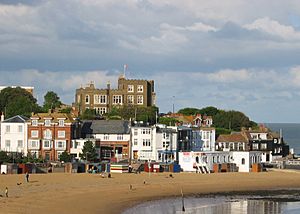
- William Bridges Adams, locomotive engineer and inventor of the Adams Axle, died at Broadstairs in 1872 and was buried at St Peter's Church.
- Sir Richard Rodney Bennett, composer and pianist, was born in Broadstairs in 1936.
- John Buchan apparently based the title of his novel, The Thirty Nine Steps after the set of steps on the beach at a house called St Cuby, Cliff Promenade at North Foreland, Broadstairs, where he was recuperating from illness in 1915.
- Thomas Russell Crampton, MICE, MIMechE, railway engineer, was born in Broadstairs in 1816.
- Charles Dickens visited Broadstairs regularly from 1837 until 1859 and described the town as "Our English Watering Place". He wrote David Copperfield while staying at Bleak House.
- Tim Edey, multi-instrumentalist and composer, grew up in Broadstairs.
- Sir Edward Heath, Prime Minister of the United Kingdom from 1970 to 1974, was born in Broadstairs in 1916 and lived there until going to study at Balliol College, Oxford in 1935.
- Edward Higgins (E. O. Higgins), fiction writer, podcaster and performer lived in Broadstairs for two years from 2009, whose novel Conversations with Spirits is based in the town
- Oliver Postgate, writer of the Clangers animated TV series, was a longtime resident of Broadstairs and his life is commemorated by a mosaic of the Clangers and a blue plaque on the front of his home in Chandos Square.
- Writer and filmmaker Bruce Robinson set his first full-length novel The Peculiar Memories of Thomas Penman in the Broadstairs. Robinson is from the town and the novel is semi-autobiographical.
- Tallulah, DJ who studied catering at East Kent College.
Images for kids
See also
 In Spanish: Broadstairs para niños
In Spanish: Broadstairs para niños




